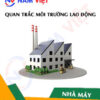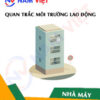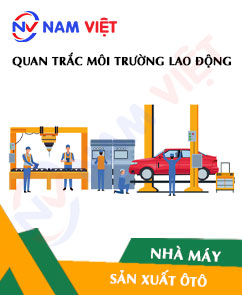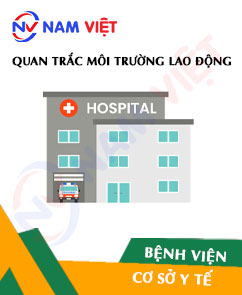Occupational environment monitoring at the factory producing automobile parts
99,000 ₫
Note: The above price is calculated for one sample, the price may fluctuate depending on the area of the environment to be monitored and the movement of the market. For more accurate price support, please refer to the quotation table or contact directly with our consulting staff.
Environmental monitoring of automobile parts manufacturing factories is a session of collecting, analyzing, and evaluating factors in the workplace that may be harmful to the health of workers.
Table of Contents
Toggle1. Overview of Automobile Parts Factories
a. What is an automobile parts factory?
Factories for automobile parts are facilities specializing in the production of car components and parts. Automobile parts include the essential components and elements needed to build, assemble, and maintain various types of vehicles.
Automobile parts factories play an important role in the automotive industry, providing high-quality components and parts to car manufacturers and the automotive repair market. Parts produced in these factories contribute to the operation, performance, and safety of vehicles on the market.

b. Production processes in automobile parts factories
The production processes in automobile parts factories generally include:
- Design and research: This is the initial stage for studying and designing automobile parts based on technical requirements and standards. It involves using CAD/CAM software to design and simulate parts before moving to the production stage.
- Processing and fabrication: This stage includes processes for manufacturing automobile parts from raw materials. Processes include cutting, bending, stamping, welding, CNC machining (Computer Numerical Control), grinding, plating, and other processes to create precise and high-quality components.
- Assembly: After the parts are produced, the assembly stage begins. Components are assembled in the correct order and process to create complete units, such as engines, suspension systems, braking systems, electrical systems, etc.
- Quality control: Parts and assemblies are inspected to ensure they meet standards and quality requirements. Testing may include dimensional checks, durability tests, precision checks, operational testing, and load-bearing capability tests.
- Packaging and transportation: After parts pass inspection, they are packaged and prepared for delivery to customers or other automobile manufacturers.

c. Machinery used in automobile parts factories
In automobile parts factories, many types of machinery and equipment are used to carry out production processes. Below are some common machines in the automobile parts industry:
- CNC Lathe: Used to machine round parts with precision, versatility, and automation.
- CNC Milling Machine: Used to machine complex parts with high accuracy. It can perform cutting, milling, drilling, and grooving on complex surfaces of parts.
- Press Machine: Used to shape, bend, or cut components by applying pressure to materials.
- Welding Machine: Used to weld metal parts together, using methods such as MIG/MAG, TIG, or spot welding.
- Punching Machine: Used to create holes, grooves, or special-shaped features on metal sheets.
- Electrical Discharge Machine (EDM): Used to machine parts by using electrical pulses for cutting, engraving, grinding, or drilling metal materials.
- Testing and Measurement Equipment: Used to ensure quality and meet technical requirements of automobile parts, including precision measurement devices, dimensional inspection tools, durability testers, and other testing equipment.

d. Occupational diseases that workers in automobile parts factories may face
Workers in automobile parts factories may be exposed to several occupational diseases such as:
- Respiratory diseases: Exposure to metal dust, chemicals, fumes, and allergens can cause respiratory issues such as asthma, pneumonia, or other respiratory problems.
- Skin diseases: Contact with chemicals, oils, solvents, and other irritants can cause dermatitis, eczema, burns, or allergic reactions.
- Hearing problems: Noise from machinery and industrial equipment can cause ear damage, hearing loss, or impaired hearing.
- Spinal and joint disorders: Incorrect posture or lifting heavy objects can cause back pain, headaches, and joint inflammation.
- Hand and neck disorders: Repetitive tasks such as cutting, grinding, or assembly can lead to wrist syndrome and other hand, arm, or neck issues.
- Eye problems: Exposure to chemicals, dust, bright light, and other irritants can cause eye inflammation, irritation, and other visual issues.
To protect workers’ health, safety measures such as personal protective equipment, proper ventilation, adherence to safe work procedures, and control of harmful agents are necessary. Additionally, implementing education programs, training, and periodic health checks is crucial.

e. Popular automobile parts on the market
There are many popular automobile parts on the market, including:
- Tires: Including regular tires, synthetic rubber tires, puncture-resistant tires, winter tires, and sports tires.
- Braking systems: Including disc brakes, drum brakes, mechanical brakes, and hydraulic brakes.
- Steering systems: Including steering wheels, drive mechanisms, shafts, gears, shifters, and steering assemblies.
- Engine systems: Including air filters, fuel systems, cooling systems, engine control systems, and starters.
- Suspension and shock absorbers: Including shock absorbers, suspension components, axles, control arms, stabilizer bars, and related accessories.
- Electrical systems: Including electronic systems, lighting, sensors, controllers, and audio systems.
- Cooling systems: Including radiators, engine cooling components, fans, and related parts.
- Clutch systems: Including clutches, drive components, bushings, and connecting parts.
- Vehicle frame systems: Including chassis, roll bars, pillars, body panels, and other frame-related parts.
- Air conditioning systems: Including temperature controllers, compressors, evaporators, and refrigerant pipes.
2. Overview of Occupational Environment Monitoring Services
a. What is occupational environment monitoring in automobile parts factories?
Occupational environment monitoring (or workplace environmental assessment) in automobile parts factories is the activity of collecting, evaluating, and analyzing measurement indicators of workplace environmental factors in order to implement timely solutions, minimize environmental hazards to workers’ health, and prevent occupational diseases. Occupational environment monitoring is a mandatory requirement for automobile parts factories.
Occupational environment monitoring plays a crucial role in caring for, protecting, and improving workers’ health, as employees are the primary resource of the company and directly generate profit. Workers who are frequently exposed to risk factors exceeding permissible limits can suffer health issues and develop occupational diseases.
REGISTER FOR OCCUPATIONAL ENVIRONMENT MONITORING SERVICE
b. An Toan Nam Viet’s occupational environment monitoring program
An Toan Nam Viet’s occupational environment monitoring program is designed by monitoring engineers specializing in occupational safety and environmental protection. Aiming to ensure workers’ health and safety, this program uses modern measurement methods to monitor air quality, water, microclimate factors, physical conditions, dust, and more within the workplace. This program is crucial for ensuring a safe working environment and protecting workers’ health.
Additionally, An Toan Nam Viet’s program plays an important role in researching and developing new solutions to improve workplace environment quality. With the dedication and professionalism of the monitoring experts, An Toan Nam Viet’s proprietary program is becoming a breakthrough in occupational safety and environmental management in Vietnam.

c. Standardization in occupational environment measurement processes
Standardization in An Toan Nam Viet’s occupational environment measurement processes is crucial to ensure measurement quality. To guarantee accuracy and reliability, the program follows recognized standards and standardized procedures of the Ho Chi Minh City Department of Health. This ensures that collected data is highly reliable for evaluating workplace conditions and making decisions to improve the working environment to protect workers’ health.
These standardized procedures also ensure that measurement results are performed by qualified monitoring experts with many years of experience, allowing managers and specialists to trust An Toan Nam Viet’s results and make precise decisions valuable for protecting workers’ health and the environment.
By applying standardization in occupational environment measurements, An Toan Nam Viet demonstrates its commitment to providing a safe working environment and protecting workers’ health, while actively contributing to the development and improvement of occupational safety and environmental management in Vietnam.
d. Reports on occupational environment monitoring results at automobile parts factories
Monitoring results are prepared according to Form No. 04, Appendix III issued with Decree 44/2016/ND-CP and are prepared in two copies: one sent to the contracting workplace and one retained by the organization conducting the monitoring.
Retention of occupational environment monitoring results is legally indefinite.

e. Frequency of occupational environment monitoring as required by law
According to Clause 2 of Article 18 of the Law on Occupational Safety and Health 84/2015/QH13, employers must conduct workplace environmental monitoring to assess harmful factors at least once per year.
f. Deadline for submitting occupational environment monitoring reports as required by law
The deadline for submitting reports is before December 31 each year. Enterprises operating production factories are required to submit occupational environment monitoring reports to the local Department of Health at the location of the head office and where employees are working.
When there are changes in technological processes, production processes, or when renovating/upgrading factories with the risk of new harmful factors to workers’ health, enterprises must update occupational hygiene records regarding harmful factors requiring occupational environment monitoring.
g. Penalties for violations regarding occupational environment monitoring for employers
According to Article 27 of Decree No. 12/2022/ND-CP dated January 17, 2022, regulating administrative penalties in labor, social insurance, and Vietnamese employees working abroad under contracts:
- Clause 2: A fine of VND 2,000,000 – 5,000,000 for employers who fail to publicly disclose monitoring results and hazard assessments to employees immediately after obtaining the results.
- Clause 3: A fine of VND 20,000,000 – 40,000,000 for employers who fail to conduct occupational environment monitoring to control hazards to workers’ health as required by law.
- Clause 4: A fine of VND 40,000,000 – 60,000,000 for employers who collude with monitoring organizations to falsify monitoring results, but not to the extent of criminal liability.
3. Harmful environmental factors for workers in automotive parts manufacturing factories
Workers in automotive parts manufacturing factories may be exposed to various harmful environmental factors, including:
- Toxic chemicals: During the production of automotive parts, chemicals such as solvents, adhesives, coatings, and cleaning agents may be used. Long-term exposure to these compounds can negatively affect health, causing skin irritation, allergies, respiratory issues, and nervous system problems.
- Dust and fine particles: The machining and manufacturing processes can generate dust and fine particles, including metal dust, abrasive dust, and dust from cutting, grinding, welding, and casting. Inhaling these particles can cause respiratory problems, such as pneumonia, difficulty breathing, and lung diseases.
- Noise: The sound environment in automotive parts factories is often very noisy due to machinery, tools, and processing activities. Prolonged exposure to high noise levels can negatively impact hearing, increase the risk of workplace accidents, and cause stress.
- Temperature and humidity: Automotive parts factories may have high temperature and humidity levels due to machinery and cooling systems. These conditions can cause discomfort, fatigue, and affect workers’ overall health.
- Physical hazards: Working in automotive parts factories may require the use of tools and equipment that pose physical risks. For example, operating cutting, grinding, casting, welding, or mechanical machinery without following safety rules can lead to injuries, cuts, collisions, and burns.
REGISTER FOR OCCUPATIONAL ENVIRONMENT MONITORING SERVICE
4. Measures to improve working conditions in automotive parts manufacturing factories
To improve working conditions in automotive parts factories and protect workers’ health, the following measures can be applied:
- Ensure ventilation and air management systems: Maintain good ventilation and air circulation within the factory. Use dust extraction systems and ventilation fans to remove dust and harmful chemical vapors from the air.
- Safety training and guidance: Provide workers with occupational safety training, including instructions on using personal protective equipment, safe work practices, and proper operation of machinery and equipment.
- Waste and chemical management: Ensure proper management of waste and chemicals. Sort, collect, and safely dispose of waste to prevent environmental pollution and health risks for workers.
- Adjust lighting and noise: Ensure natural lighting and provide adequate artificial lighting in work areas. Control noise and provide hearing protection to reduce noise-related health impacts.
- Periodic machinery inspection and maintenance: Regularly inspect, maintain, and clean machinery and equipment to ensure safe operation and minimize accident risks.
- Ensure use of personal protective equipment: Require uniforms and personal protective equipment (including helmets, goggles, gloves, masks, safety shoes, etc.) to safeguard workers’ safety.
- Promote a safety culture: Build a safety culture in the factory by raising awareness and commitment among all employees regarding occupational safety. Encourage active participation in training programs and safety-related activities.
- Periodically conduct occupational environment monitoring in factories to collect and analyze harmful factors affecting workers, then adjust measures to reduce risks and prevent occupational diseases.
5. Benefits of periodic monitoring in automotive parts factories
An Toan Nam Viet provides businesses with outstanding advantages when using occupational environment monitoring services according to Decree 44/2016/ND-CP on managing and controlling harmful workplace factors affecting employees.
- Businesses can proactively control harmful factors in workshops or factories.
- Receive recommendations on measures to reduce harmful factors and improve workplace quality.
- Indirectly protect human resources, a key factor in business development.
- Reduce the harmful impact of occupational diseases on health, minimizing future treatment costs.
- Improve worker health, ensuring product quality and maintaining production output.
- Ensure compliance with labor safety laws and avoid legal risks.
- Enhance credibility and professionalism in all aspects, elevating the company brand.
Nam Viet’s environmental monitoring service is a solution to reduce occupational disease risks, contributing to a clean and high-quality working environment.

6. National occupational environment monitoring center
Occupational environment monitoring center of Nam Viet is a professional unit for supervising and measuring workplace environmental quality across all provinces in Vietnam. With a team of experienced monitoring specialists, the center uses modern measurement equipment to ensure accuracy and reliability.
In addition to monitoring services, the center assists clients in planning, managing, and tracking workplace environmental issues. With the motto “customer-centered,” the center prioritizes customer satisfaction, meets all client needs, and is committed to providing the best solutions for businesses.
REGISTER FOR OCCUPATIONAL ENVIRONMENT MONITORING SERVICE
With investments in technology, equipment, and human resources, Nam Viet’s monitoring center has become one of the most reputable units in occupational environment monitoring in Ho Chi Minh City, with the following objectives:
- We always value our brand reputation and service quality.
- We provide clients with the best and most suitable solutions possible.
- Alongside a team of experienced Masters and Engineers, committed to environmental protection and business benefit.
- At Nam Viet Environmental Monitoring, companies receive professional service from field experts and the best cost advantages.
The occupational environment monitoring process at Nam Viet includes the following basic steps:
- Before conducting monitoring, our company ensures all equipment is calibrated according to legal regulations.
- Follow the occupational environment monitoring procedures committed to the Department of Health accurately and fully.
- Report monitoring results honestly to employers.
- If monitoring results indicate unsafe conditions, Nam Viet provides corrective solutions, and the workplace implements the following:
- Implement measures to improve working conditions, minimize harmful factor impacts, and prevent occupational diseases.
- Conduct health examinations to detect occupational and related diseases early for workers in unsafe environments.
- Provide in-kind compensation to workers according to labor law.

7. Occupational environment monitoring quotation
To help businesses conduct professional and effective occupational environment monitoring, Nam Viet provides clients with a quotation for occupational environment monitoring services with quality and reasonable costs.
- Our quotation provides detailed pricing information for the monitoring services we offer, including costs related to travel, measurement, analysis, and reporting. Clients can trust the accuracy and reliability of the monitoring reports we provide.
- We commit to offering competitive and reasonable prices in the market and are always ready to provide quick and professional advice for any inquiries regarding monitoring services.
- With Nam Viet’s monitoring quotation, clients can easily select service packages suitable to their needs. We are committed to delivering the highest satisfaction with professional service quality.
No comments yet












Review Occupational environment monitoring at the factory producing automobile parts
There are no reviews yet.